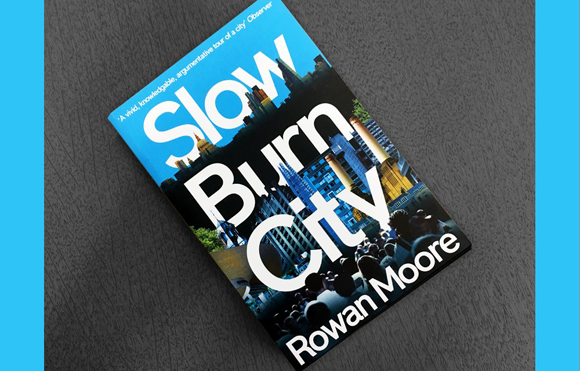Post
BOOK REVIEW | Slow Burn City by Rowan Moore
26 May 2020
Slow Burn City, The secrets behind London's buildings
by Rowan Moore
Reviewed by Jonathan Manns
Slow Burn City, now out in paperback, is both a description of what London is and, by implication, what it could be. A guide to the capital today, it’s a readable if often disjointed testament to one man’s infuriation with hollow marketing spiel, dull design and incompetent professionals.
Rowan Moore is the acclaimed architecture critic for the Observer; formerly he's been editor of the architecture journal Blueprint, director of the Architecture Foundation, and contributor to the Evening Standard. Named Critic of the Year at the UK Press Awards in 2014, he is known for concise, focussed, and often stinging analyses. Regrettably, Slow Burn City falls short of delivering a consistent barrage of Moore at his best. The result is an elegantly written and occasionally polemic, but equally fragmented and rambling, tour of London’s built environment. The title is intended to convey the way in which London is changed and renewed by re- consuming what it’s already made and it’s hard not to feel that the book embodies this itself.
There are, of course, moments where Moore unleashes his devastatingly engaging, informed and eloquent powers of communication. His assessment of the so-called 'history wall' in HSBC’s Canary Wharf HQ (an art installation for the foyer, prepared by the company archives team in association with Heatherwick Studio) is not merely lobby decoration but a 'pyongyangian exercise in obedience and propaganda' which attempts 'inculcation with ethical amnesia'.
What lets Slow Burn City down is that Moore’s trademark flourishes are found only by panning through some 500 pages of less vivid and expressive text. If only the publisher, Picador, could have more enthusiastically offered their red pen. A tighter edit could have sat alongside the near-totemic commentary of Ian Nairn or Steen Eiler Rasmussen.
There are points at which we’re forced to wonder whether Slow Burn City was meant to be read as a composite. (Certain people, such as the City of London’s former chief planning officer, Peter Rees, are introduced repeatedly.) The content of each chapter is only loosely related to each theme at best and, consequently, each blurs into the other.
As a descriptive work, Slow Burn City has a gentle flow which carries the reader along, a little awkwardly at first via London Zoo and sex-related entertainment but finding pace when the issue of housing is fully broached near the halfway point. In some ways the reader’s overall experience is not unlike a visitor’s first trip to London: an initially overwhelming jumble of seemingly unrelated things which ultimately help form a cumulative impression.
At the end, Moore presents a manifesto for change. Unexpected and unclimactic, it’s a collection of eminently sensible conclusions about how to shape London in the future, but which lacks any route map. Yet this is the moment that Slow Burn City finally drops anchor. This is the moment at which Moore’s disdainful, nostalgic and fundamentally hopeful romp across London makes sense. If only it was at the start.
'The ideal of London,' writes Moore, 'is that it is available and open. It gives opportunities and freedoms. Its common assets can be shared by all. It is competitive but generous. All identities are possible, but not mutually exclusive.' It’s hard for anybody who believes in a modern, liberal, diverse and pluralistic London to dispute these ambitions. It’s also very evident that these underpin the book’s analysis of the capital today. It is in this spirit which Moore flags two 'main needs', both specific and general; for new and affordable homes and an enhancement of the qualities that make the city worth living in. Each is dealt with in a rational and sensible manner; supporting towers if well-designed and located, building on the green belt if done with care.
Moore has lived in London for more than 30 years and, with a keen eye for design, has watched it change. Slow Burn City is testament to his infuriation at what he’s witnessed.
'London, important in itself, represents qualities that are everywhere challenged,' he concludes, 'abundant, dynamic and awed, it has the genius to create examples that can change the world.' This book might not be the call-to-arms that London needs to ensure the right decisions are taken, or even the clearest rallying cry, but it’s a welcome and notable addition to the chorus.
